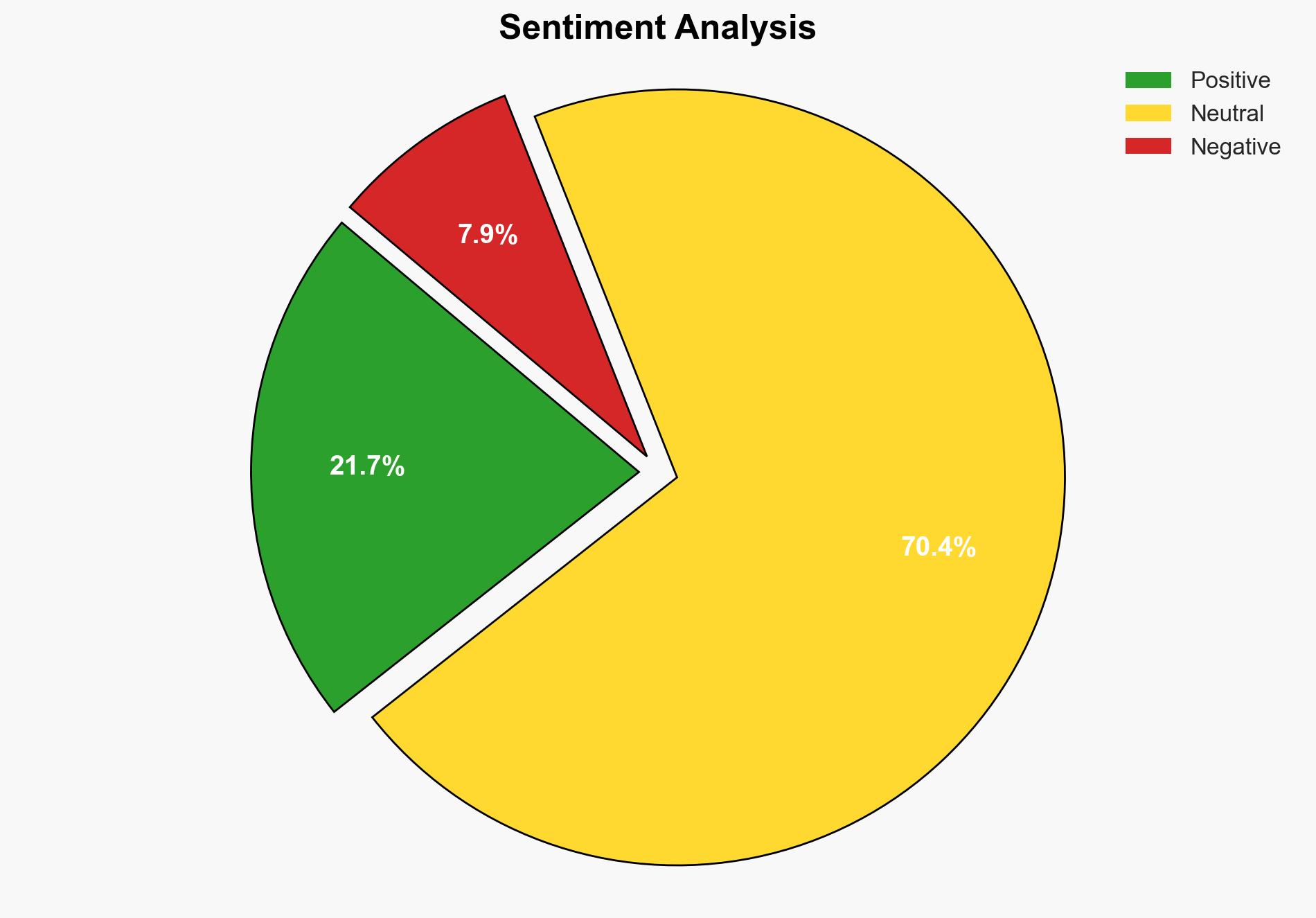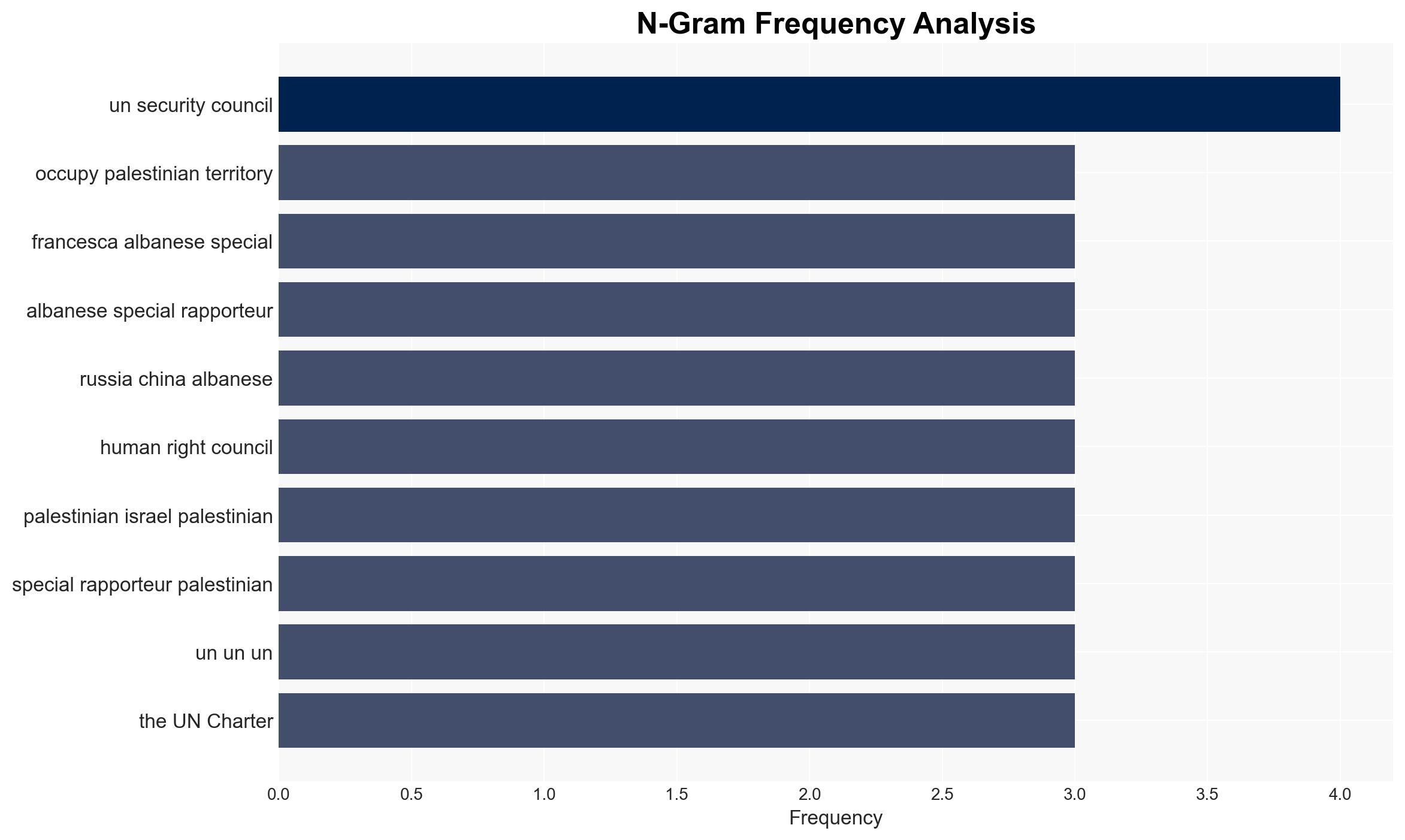UN Security Council resolution a violation of Palestinian right of self-determination and UN Charter UN expert warns – Globalsecurity.org
Published on: 2025-11-20
AI-powered OSINT brief from verified open sources. Automated NLP signal extraction with human verification. See our Methodology and Why WorldWideWatchers.
Intelligence Report:
1. BLUF (Bottom Line Up Front)
The UN Security Council resolution is perceived as a violation of Palestinian self-determination rights and may exacerbate tensions in the region. The most supported hypothesis is that the resolution is part of a broader geopolitical strategy that prioritizes stability over self-determination, potentially leading to increased unrest. Confidence Level: Moderate. Recommended action includes diplomatic engagement to address the resolution’s implications and promote a balanced approach to regional stability.
2. Competing Hypotheses
Hypothesis 1: The resolution is primarily aimed at stabilizing the region by focusing on security and disarmament, albeit at the expense of Palestinian self-determination. This hypothesis suggests that the resolution is a pragmatic approach to immediate security concerns, prioritizing the cessation of violence and the establishment of order.
Hypothesis 2: The resolution is a strategic maneuver to consolidate external control over Palestinian territories, undermining their right to self-determination. This perspective views the resolution as a means to entrench existing power dynamics and suppress Palestinian autonomy.
The most likely hypothesis is Hypothesis 1, given the international community’s historical focus on security and stability in conflict zones. However, elements of Hypothesis 2 cannot be dismissed, especially considering the geopolitical interests involved.
3. Key Assumptions and Red Flags
Assumptions: The resolution’s primary intent is to stabilize the region; international actors are acting in good faith to uphold international law.
Red Flags: The resolution’s potential to entrench power asymmetries; lack of explicit measures to ensure Palestinian self-determination; possible bias from involved parties with vested interests.
Deception Indicators: Diplomatic rhetoric that emphasizes peace and stability without addressing underlying grievances; potential manipulation of international law to justify actions.
4. Implications and Strategic Risks
The resolution may lead to increased political unrest and violence if perceived as undermining Palestinian rights. It could also strain relations between key international actors, such as the United States, Russia, and China, affecting broader geopolitical dynamics. There is a risk of escalating tensions leading to economic sanctions or cyber operations targeting involved parties. The informational landscape may become more polarized, with increased propaganda and disinformation campaigns.
5. Recommendations and Outlook
- Engage in diplomatic dialogue to address concerns regarding the resolution’s impact on Palestinian self-determination.
- Encourage international oversight to ensure the resolution’s implementation aligns with human rights and international law.
- Monitor regional developments closely to anticipate potential escalation and prepare contingency plans.
- Best Scenario: The resolution leads to a sustainable ceasefire and paves the way for renewed peace negotiations.
- Worst Scenario: The resolution exacerbates tensions, leading to widespread violence and regional instability.
- Most-likely Scenario: The resolution results in temporary stability but fails to address long-term grievances, maintaining a cycle of unrest.
6. Key Individuals and Entities
Francesca Albanese – Special Rapporteur on the situation of human rights in the Palestinian territory.
United States – Active party in the conflict with military, economic, and diplomatic influence.
Russia and China – Abstained from the resolution, indicating potential geopolitical interests.
7. Thematic Tags
Structured Analytic Techniques Applied
- Cognitive Bias Stress Test: Expose and correct potential biases in assessments through red-teaming and structured challenge.
- Bayesian Scenario Modeling: Use probabilistic forecasting for conflict trajectories or escalation likelihood.
- Network Influence Mapping: Map relationships between state and non-state actors for impact estimation.
Explore more:
National Security Threats Briefs ·
Daily Summary ·
Support us





